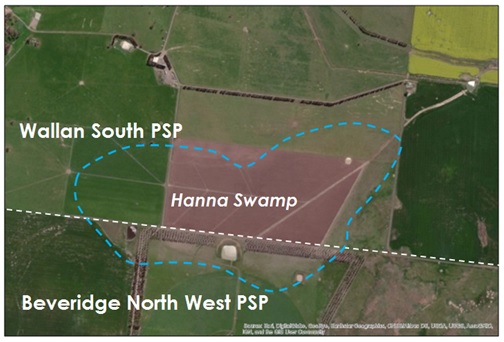Hanna Swamp has become a fascinating test case for urban waterway policy in Melbourne
Back in the July newsletter, we released a discussion paper and revisited the story of Hanna Swamp, a long drained and modified (formerly in-stream) wetland of Strathaird Creek near Wallan, situated in the approved urban growth corridor north of Melbourne.
Not long after the release of that discussion paper, much of its policy and scientific content was adapted and used by the Friends of Merri Creek to highlight the complex issues facing wetlands like Hanna Swamp at a Planning Panel hearing. This particular hearing was reviewing the Precinct Structure Plan for the Beveridge North West PSP area, as exhibited by the Victorian Planning Authority (VPA), an area that includes the southern quarter of Hanna Swamp. When wetlands straddle both property and planning zone boundaries like this, it often triggers a complex series of planning, practical and technical difficulties, and this case is no different.

Earlier this month, the Planning Panel released their full report, which provides multiple references to Hanna Swamp – as the specific location of this wetland is intimately tied to issues relating to things like development character, open space, liveability, zoning, drainage, catchment management and biodiversity. If you download the full report, those reference can be found on pages: v, 59, 63, 93-95, and 98-103. The bulk of discussion can be found on pages 98-103 in the Biodiversity section, and so these are reproduced in the pdf viewer at the end of this article.
However, in the summary of this section of the report (page 102), the Planning Panel says:
“It is not clear why Hanna Swamp has been overlooked for consideration in the PSP. Not being identified in the Melbourne Strategic Assessment does not provide sufficient justification given the broad range of state, regional and local planning policy that points to wetland protection and restoration.
Hanna Swamp could be viewed as a ‘wet paddock’ requiring no special treatment except drainage for urban development. This however would be a simplistic view that fails to account for the important role that such wetlands play in both hydrological and ecological systems. There are many examples in urban and regional contexts (including recent large scale greenfield development) where permanent and ephemeral wetland restoration can provide a significant community resource for recreation and passive open space with all the societal, as well as ecological benefits that can result.
The Panel is not able to say that all of Hanna Swamp must be protected. As noted a significant portion of it is in the Wallan South PSP. However, the Panel does consider there should be further investigation of how Hanna Swamp might be protected, and its natural values restored and utilised in planning for both PSPs. To do otherwise would be a significant lost opportunity.
The panel concludes:
• The PSP area has relatively low biodiversity values.
• That said, the restoration of habitat and ecological function should be more strongly pursued in the PSP to achieve broader conservation outcomes but also to improve the liveability of new communities in the PSP.
• That part of Hanna Swamp in the Beveridge North West PSP should be more clearly identified and actively planned for to ensure the opportunities for wetland and waterway management and habitat restoration are not missed.“
The response of the VPA and other agencies to these recommendations is set to determine both the future of Hanna Swamp, and also the character of urban development in this part of Melbourne – specifically whether modified natural wetlands and waterways are to be actively restored and integrated into future urban design. This key urban design principle is strongly embedded within both the Healthy Waterways Strategy and Local / State Planning Policy Frameworks, but is not currently implemented or recognised as part of ‘business-as-usual’ practices in the urban growth zone.
Hence this case study is something that has far wider implications than the relatively modest individual example of Hanna Swamp.

If you are interested in the eventual outcome of this fascinating and important topic of urban waterway planning policy, then please keep an eye out in future NGT newsletters for updates.
Otherwise, if you have any comments or questions about this issue, you can always send me an email.
PS – Pages 98-103 of the Planning Panel report are reproduced below…
